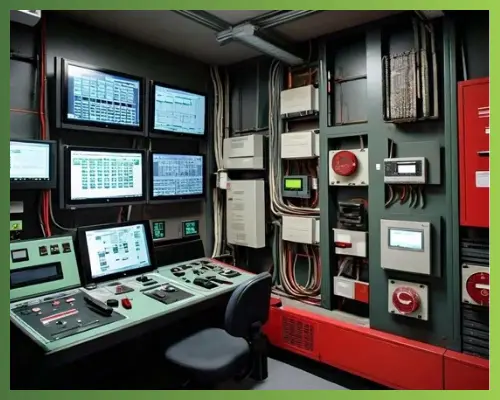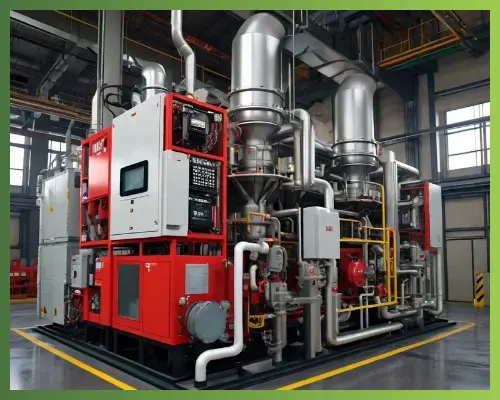Imagine a huge thermal power facility in Pakistan, pulsating with the energy of producing electricity. The workers are busy with their daily jobs. Everyone is doing their work.
As there is always a high chance of fire outbreaks, The firefighting system for thermal power plants in Pakistan is a silent protector among the tangle of turbines and control rooms.
Contact us today to invest in Green Tech’s fire-fighting solutions to save money and the planet.

Table of Contents
ToggleFire protection system in thermal power plant is essential in Pakistan. As the presence of highly inflammable liquids and oils, these extinguishing systems limit the destruction caused by fire.
Moreover, these systems are used mostly as fire extinguishing in thermal plants and as they are highly effective.
The Fire Alarm Control Panel is the central control center of the fire alarm . This tells each component what to do and when.
The following are 3 main benefits

Thermal fire protection ensure to inform staff about fire in early stage, so they may leave safely.
Assists in adhering to building codes and fire safety standards.
Reduces property damage by notifying law enforcement and turning on suppression systems.
Water remains the most commonly used for fire protection in power plants due to its effectiveness in cooling flames and preventing fire spread. This system includes:
Fire Pumps: A power plant typically has three types of pumps:
Jockey Pump: Maintains system pressure to avoid unnecessary activation of main fire pumps.
Electric Fire Pump: The primary pump that delivers water to the fire suppression system.
Diesel Fire Pump: A backup pump that ensures the system works even if power is lost.
Sprinkler Systems: These automatically activate when a fire is detected, spraying water to suppress the flames.
Hydrant Systems: Fire hydrants are strategically placed across the plant to allow firefighters quick access to water.
Power plant fire suppression handles flammable liquids like lubricating oils and hydraulic fluids, which can’t be controlled using water alone. That’s where foam-based systems come in.
Foam Concentrate: A special liquid that, when mixed with water, creates a thick foam that covers the fire and cuts off oxygen.
Foam Proportioning System: Ensures the correct mixing of water and foam concentrate for effective suppression.
Foam Sprinklers & Nozzles: Placed in areas prone to oil or chemical fires, releasing foam automatically or manually when needed.
Electrical equipment, gas turbines, and generators require a clean firefighting solution that won’t damage sensitive components. CO2 systems are ideal because they extinguish fires without leaving residue.
CO2 Gas: Displaces oxygen around the fire, suffocating it quickly.
Automatic Detection & Release: The system detects fire through heat or smoke sensors and automatically releases CO2.
Manual Activation Option: Allows operators to trigger the system if an automatic release fails.
Used in areas where water or foam might not be suitable, dry chemical systems effectively extinguish fires involving fuels, oils, and gases.
Chemical Powder: A specialized dry chemical (such as sodium bicarbonate or potassium bicarbonate) interrupts the fire’s chemical reaction.
Rapid Discharge: The system quickly spreads the powder to suppress the flames before they spread.
No Water Damage: Ideal for protecting sensitive equipment in power plants.
FM-200 is a clean agent fire suppressant that works similarly to CO2 but is safer for human exposure. It’s widely used in control rooms and areas with high-value electrical equipment.
Fast Response: Extinguishes fires within seconds, minimizing damage.
No Residue: Leaves no water or chemical residue, making cleanup easy.
Safe for People: Unlike CO2, FM-200 allows personnel time to evacuate before reaching dangerous concentration levels.
According to MDPI, Pakistan faced 175,000 fire events from 2001 to 2020, among which 22,311 were categorized as wildfires.
These figures highlight the need to install strong fire safety solutions for power station fire protection to prevent fires and lessen their effects.
A thermal power plant’s coal transportation system moves coal from storage yards to the boiler so that it can be burned. It usually consists of feeders, crushers, and conveyors.
Install fire detection devices in storage rooms and along conveyor belts to identify overheating and fires. To contain flames, use fire-resistant materials for enclosures and conveyor belts.
It consists of the ash handling , burners, and boiler. Coal is burned in the combustion system to produce heat, which is then utilized to create steam, which powers turbines.
Install oxygen sensors (CO2 extinguisher) and flame detectors to monitor the combustion process and identify unusual circumstances.
Install fire suppression and automated shutdown mechanisms to stop and contain fires.
It consists of storage tanks, pumps, and pipelines where fuel oil is fed into the combustion system during startup and shutdown.
Install automatic systems for detecting and suppressing fires around oil pipelines and storage locations. Use fire-resistant materials for enclosures and tanks used for oil storage.
The National Fire Protection Association publishes fire safety standards and codes, such as NFPA 72 (National Fire Alarm and Signaling Code), NFPA 101 (Life Safety Code), and NFPA 1 (Fire Code).
Building codes, such as the International Building Code (IBC) and International Fire Code (IFC), provide requirements for fire safety in both new and existing structures.
Maximum occupancy restrictions should be set for rooms and buildings according to their size and intended usage to allow for a safe evacuation in the event of a fire.
Fire alarm must be installed to alert occupants to potential fires and detect them early.
Install emergency exit lighting in buildings to offer light if there is a power outage during a fire.
Upgrade your fire protection system in a thermal power plant to meet current safety standards.

Area | Description |
Turbine Hall | Houses turbines, generators, and associated equipment, requiring protection from fire and hazards. |
Control Room | Nerve center where operators monitor and control operations, requiring protection for personnel and equipment. |
Electrical Switchyards | Contains high-voltage electrical equipment, needing protection from fire and hazards to maintain power supply. |
Fuel Storage and Handling | Stores and handles fuel such as coal, oil, or gas, needing protection from fire and hazards to prevent accidents. |
Boiler and Steam Systems | Critical components need protection from fire and hazards to ensure safe and efficient operation. |
Cooling Towers | Structures used for heat dissipation, require protection from fire and structural damage. |
Water Treatment Facilities | Facilities for treating water, needing protection from contamination and hazards for operational safety. |
Access and Egress Routes | Corridors, stairways, and exits need protection for safe evacuation in emergencies. |
ASPECT | DESCRIPTION |
Purpose | Stores water for fire-fighting purposes |
Equipment | Equipped with pumps to maintain pressure and flow rate |
Usage | Water is used for fire suppression and cooling in emergencies |
Capacity | Reservoirs are constructed with sufficient capacity to meet fire protection needs |
Backup Power | Pump houses may have backup power sources to ensure continuous operation in case of power failure |
Green Tech Solution also offers
· Fire Protection for Power Station
· Fire Fighting System in Power Plants
· Fire Protection System for Coal Handling Plant
To provide a prompt and efficient response to fires, power plants’ fire fighting systems often use:
The coal handling system in a thermal power plant is designed for the transportation, storage, and processing of coal to provide a steady supply to the boiler for electricity production. It consists of several components, such as conveyors, crushers, feeders, and bunkers to manage coal from unloading at the plant to feeding it into the boiler.
To sum up, the fire fighting system for thermal power plants in Pakistan is essential for protecting these establishments from fire threats.
It contributes to the dependable and effective operation of the nation’s thermal power plants.
So don’t wait, contact us for fa ire protection system for a power plant now!